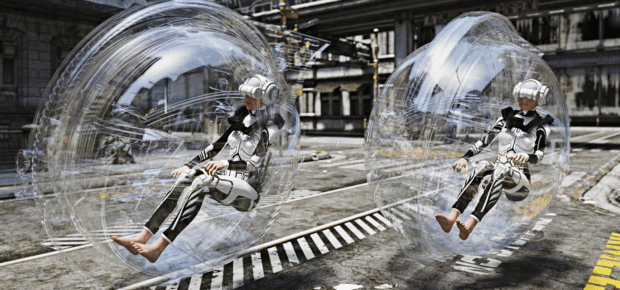November 12, 2018
Since entertainment and gaming are typically the focal points for virtual and mixed reality, it’s easy to only think in those contexts. While advancements in those two areas are likely to continue for the foreseeable future, the same VR technologies will significantly impact other areas of society as well. We’ve discussed [training] and [urban planning], but a major potential application is something that hasn’t gotten a lot of attention yet: transportation.
For consumers, the process of researching and buying a vehicle is likely to be one of the first ways they interact with VR outside of entertainment: “Virtual reality technology is being used by major automotive brands to showcase their products. Customers can try everything, from examining vehicle features to test driving,” says IEEE member Sukanya Mandal.
VR’s involvement with cars and trucks doesn’t start at the point of sale — this technology will have an impact throughout the design process, too. Mandal again: “For automotive designers and engineers, VR’s realistic elements allow them to analyze how a new vehicle will look or test its efficiency without having to build multiple models, reducing time and cost.” This change in process would benefit consumers as well as the environment.
As designs are ready to move to production, there’s an entire emerging field called Industrial Augmented Reality (IAR) that’s improving how factories and warehouses operate. Research published on IEEE Xplore covers the entire IAR lifecycle in a shipyard, and the tremendous benefits to the shipbuilding process. IAR can help provide workers with instructions, train new hires, visualize the location of products and tools, alert employees of predictive maintenance, augment employee communication, visualize equipment in dark and hidden areas and more.
When it comes to aircraft, virtual and mixed reality stand to make complex systems easier to operate, in turn improving safety, a highly desirable outcome. “To envision how transformational this can be, imagine a pilot being able to manipulate sensitive engine controls within an aircraft by merely a hand gesture,” says IEEE member Saumya Sharma.
A similar concept is making waves in the world of drone piloting, but using the body instead of the hand. Researchers have found that torso control is generally easier to learn and more intuitive than a joystick when it comes to flying a drone. The learnings from this work, aside from impacting other vehicles, stand to come full circle and improve control in VR gaming.






 The Impact of Technology in 2025
The Impact of Technology in 2025 Quantum and AI: Safeguards or Threats to Cybersecurity?
Quantum and AI: Safeguards or Threats to Cybersecurity? Why AI Can't Live Without Us
Why AI Can't Live Without Us Bits, Bytes, Buildings and Bridges: Digital-Driven Infrastructure
Bits, Bytes, Buildings and Bridges: Digital-Driven Infrastructure Impact of Technology in 2024
Impact of Technology in 2024 Emerging AI Cybersecurity Challenges and Solutions
Emerging AI Cybersecurity Challenges and Solutions The Skies are Unlimited
The Skies are Unlimited Smart Cities 2030: How Tech is Reshaping Urbanscapes
Smart Cities 2030: How Tech is Reshaping Urbanscapes Impact of Technology 2023
Impact of Technology 2023 Cybersecurity for Life-Changing Innovations
Cybersecurity for Life-Changing Innovations Smarter Wearables Healthier Life
Smarter Wearables Healthier Life Infrastructure In Motion
Infrastructure In Motion The Impact of Tech in 2022 and Beyond
The Impact of Tech in 2022 and Beyond Cybersecurity, Technology and Protecting Our World
Cybersecurity, Technology and Protecting Our World How Technology Helps us Understand Our Health and Wellness
How Technology Helps us Understand Our Health and Wellness The Resilience of Humanity
The Resilience of Humanity Harnessing and Sustaining our Natural Resources
Harnessing and Sustaining our Natural Resources Creating Healthy Spaces Through Technology
Creating Healthy Spaces Through Technology Exceptional Infrastructure Challenges, Technology and Humanity
Exceptional Infrastructure Challenges, Technology and Humanity The Global Impact of IEEE's 802 Standards
The Global Impact of IEEE's 802 Standards Scenes of our Cyber Lives: The Security Threats and Technology Solutions Protecting Us
Scenes of our Cyber Lives: The Security Threats and Technology Solutions Protecting Us How Millennial Parents are Embracing Health and Wellness Technologies for Their Generation Alpha Kids
How Millennial Parents are Embracing Health and Wellness Technologies for Their Generation Alpha Kids Space Exploration, Technology and Our Lives
Space Exploration, Technology and Our Lives Global Innovation and the Environment
Global Innovation and the Environment How Technology, Privacy and Security are Changing Each Other (And Us)
How Technology, Privacy and Security are Changing Each Other (And Us) Find us in booth 31506, LVCC South Hall 3 and experience the Technology Moon Walk
Find us in booth 31506, LVCC South Hall 3 and experience the Technology Moon Walk Virtual and Mixed Reality
Virtual and Mixed Reality How Robots are Improving our Health
How Robots are Improving our Health IEEE Experts and the Robots They are Teaching
IEEE Experts and the Robots They are Teaching See how millennial parents around the world see AI impacting the lives of their tech-infused offspring
See how millennial parents around the world see AI impacting the lives of their tech-infused offspring Take the journey from farm to table and learn how IoT will help us reach the rising demand for food production
Take the journey from farm to table and learn how IoT will help us reach the rising demand for food production Watch technical experts discuss the latest cyber threats
Watch technical experts discuss the latest cyber threats Explore how researchers, teachers, explorers, healthcare and medical professionals use immersive technologies
Explore how researchers, teachers, explorers, healthcare and medical professionals use immersive technologies Follow the timeline to see how Generation AI will be impacted by technology
Follow the timeline to see how Generation AI will be impacted by technology Learn how your IoT data can be used by experiencing a day in a connected life
Learn how your IoT data can be used by experiencing a day in a connected life Listen to technical experts discuss the biggest security threats today
Listen to technical experts discuss the biggest security threats today See how tech has influenced and evolved with the Games
See how tech has influenced and evolved with the Games Enter our virtual home to explore the IoT (Internet of Things) technologies
Enter our virtual home to explore the IoT (Internet of Things) technologies Explore an interactive map showcasing exciting innovations in robotics
Explore an interactive map showcasing exciting innovations in robotics Interactively explore A.I. in recent Hollywood movies
Interactively explore A.I. in recent Hollywood movies Get immersed in technologies that will improve patients' lives
Get immersed in technologies that will improve patients' lives